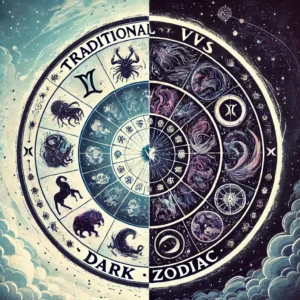Ever wondered why your zodiac sign feels like it’s hiding something? What Are The Differences between Traditional and Dark Zodiacs? – Astrology splits into two worlds: the Traditional Zodiac and the Dark Zodiac. One’s a beacon of light, the other a plunge into shadow. Traditional astrology cheers your strengths—think courage or charm – while the Dark Zodiac drags out the skeletons: fears, flaws, and the chaos you’d rather bury. Curious which lens fits you?

What are the Differences between Traditional and Dark Zodiacs?
While the traditional zodiac highlights the light and positive aspects of human nature, the Dark Zodiac delves into our fears, flaws, and the parts of ourselves we often try to suppress.
How Does Focus Differ Between the Two?
What’s the big divide? Traditional astrology is your cheerleader, spotlighting the bright side:
- Aries: Bold and brave.
- Leo: A natural leader.
- Pisces: Dreamy and kind.
The Dark Zodiac flips it—Aries becomes The Blood Ram, all rage and ruin; Leo morphs into The Ferocious Beast, a tyrant drunk on pride; Pisces sinks as The Drowning Soul, lost in torment. It’s light versus shadow, growth versus grit.
Why Is It Growth vs. Confrontation?
What’s the goal here? Traditional zodiac’s all about climbing higher -self-improvement, balance, harmony. It’s a roadmap to your best self. The Dark Zodiac? It’s a mirror to your worst:
- Virgo’s precision twists into The Broken Maiden’s obsessive spiral.
- Libra’s fairness sours into The Crooked Scales’ corruption.
It’s not about fixing – it’s about facing the mess head-on, a cosmic dare to wrestle your demons.
What Are the Archetypes Like in Each?
Who do you become in these zodiacs? Traditional signs cast you as heroes:
- Cancer: The nurturing protector.
- Sagittarius: The bold explorer.
Dark Zodiac recasts them as horror’s stars—Cancer’s The Abyssal Crab, clutching with paranoia; Sagittarius turns The Hunter of Shadows, chasing truth into madness. One inspires; the other haunts.
How Do Emotions Play Out Differently?
How do feelings fit in? Traditional astrology seeks emotional peace – Taurus builds steady love, Scorpio dives into deep bonds. It’s about balance. The Dark Zodiac thrives on turmoil:
- Taurus’ Fallen Demon hoards with greed.
- Scorpio’s Venomous Scorpion stings with vengeance.
Here, emotions don’t heal – they fester, driving chaos over calm.
Is It Idealism or Brutal Reality?
What’s the vibe – dreams or truth? Traditional zodiac paints an optimistic picture—challenges, sure, but fixable with effort. Gemini’s chatter can charm; Capricorn’s grind can win. The Dark Zodiac doesn’t flinch:
- Gemini’s Silent Assassin lie and split.
- Capricorn’s Leviathan sacrifices all for power.
It’s the raw fallout of letting your dark side run wild – no sugar coating, just reality’s bite.
How Do Cultural Vibes Shape Each Zodiac?
What’s the cultural pull? Traditional astrology vibes with self-help and wellness—think yoga retreats and life coaches. It’s about enlightenment. The Dark Zodiac leans into the eerie:
- Horror flicks where Aquarius’ Beast experiments without mercy.
- Occult tales where Scorpio’s Ravenous poisons the plot.
It’s a magnet for those hooked on mystery and the macabre.
What Do The Traditional and Dark Zodiacs Reveal About You?
What’s each zodiac showing you? The difference between Traditional and Dark Zodiacs is that Traditional astrology hands you a guide to your potential – Cancer’s War Maiden builds bridges, Virgo’s Maelstrom crafts success. The Dark Zodiac digs deeper:
- Cancer’s abyss traps you in fear.
- Virgo’s brokenness chokes you with control.
One lifts you up; the other drags you down to face the truth.
How Can You Use Both Traditional and Dark Zodiacs Together?
Why pick one when you can blend them? Traditional zodiac lights your path – Leo’s charisma shines bright. Dark Zodiac tempers it – The Ferocious Beast warns of pride’s fall. The difference between Traditional and Dark Zodiacs is that together, they’re a full picture: strengths to chase, shadows to tame. It’s not a fight – it’s a dance of self-awareness.
Which Zodiac Speaks to You – Traditional or Dark Zodiacs?
So, where do you stand? Traditional astrology offers hope and harmony – a way to grow into your best self. The Dark Zodiac dares you to confront the ugly bits – the rage, the greed, the despair. Both peel back layers of the human experience, but one’s a warm glow, the other a cold shiver. Which calls louder – light or dark?
FAQ: Quick Answers to The Differences between Traditional and Dark Zodiacs?
A: Traditional focuses on strengths and growth; Dark dives into fears and flaws.
A: Traditional boosts your best traits; Dark amplifies your hidden chaos.
A: It flips every bright trait – like Leo’s leadership – into a dark twin, like tyranny.
A: Traditional guides your potential; Dark forces you to face your shadows.
A: It’s a fuller you – balancing light’s promise with dark’s truth for real growth.
Thank you for reading about the differences between Traditional and Dark Zodiacs
